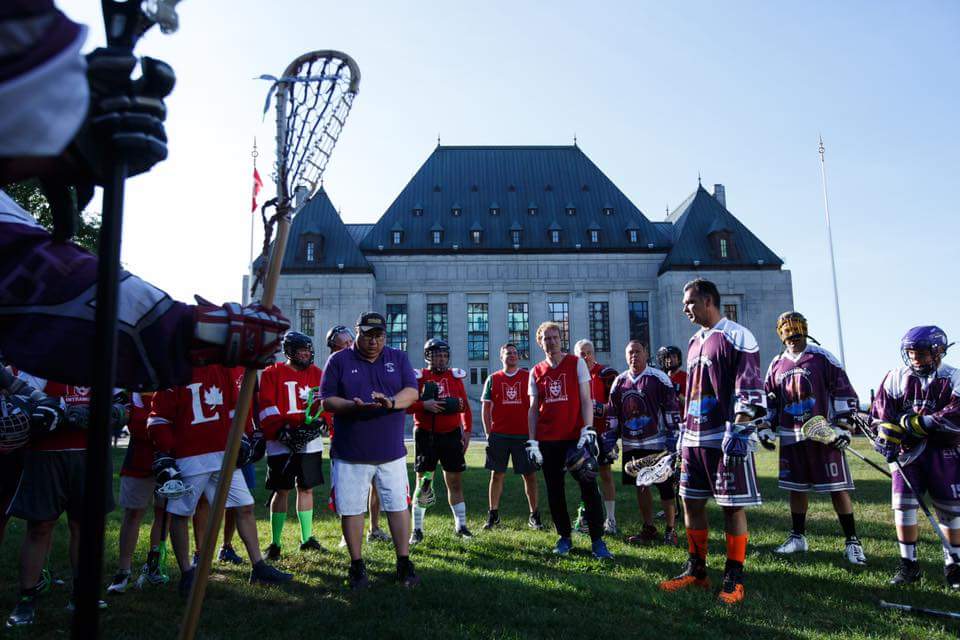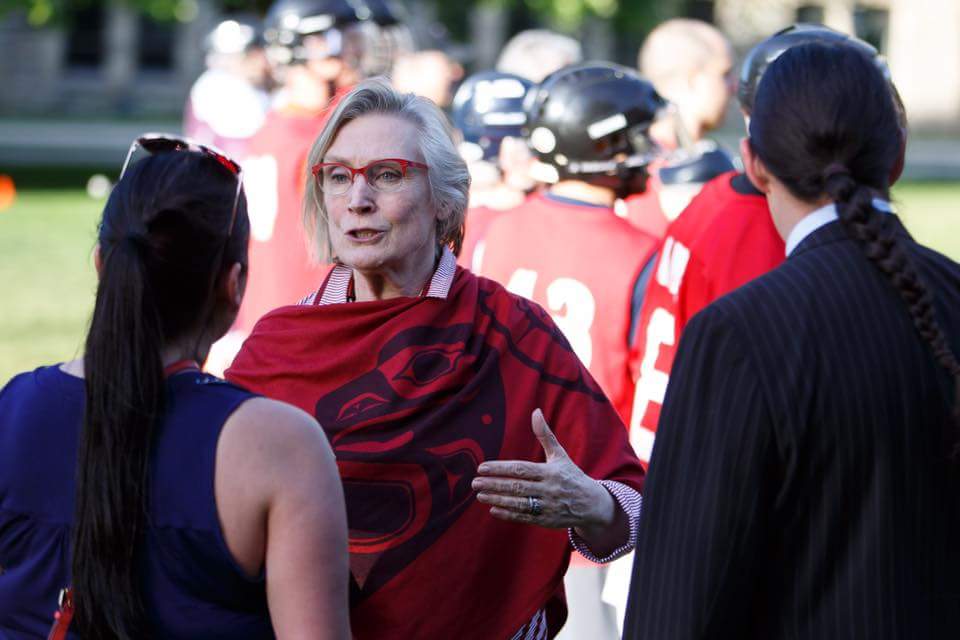
Lacrosse players from the Iroquois Confederacy gathered in Ottawa on the Supreme Court lawn just before sundown to face-off some members of parliament.
It was only a few weeks ago, in June, that Canadian Liberal MP Marc Miller, invited members of the Kahnawake Rapids to play an “exhibition game” of lacrosse. It is after all, Canada’s summer sport, and as part of their 150th anniversary celebrations, they are commemorating their birthday with the inclusion of the country’s Indigenous people, their language, culture and heritage.
The invitation to play the ‘Creators Game’ was organized by Kahnawake:ronon and Rapids owner, Sterling Deer, and Miller, the Parliamentary Secretary to the Minister of Infrastructure and Communities, — in order to raise awareness and create a positive impact for this ‘Nation to First Nations’ relation.
Deer said the event transpired in to a historical moment for Haudenosaunee people. “Marc is a friend of mine and he asked if I could get a team together to play a game. He had some friends, including some other MPs, and a few others that either played in high school or had a background in hockey, so they had some knowledge of the game. We had a few novice/bantam players mixed in; they asked to bring younger kids, so I got a few to play on the team,” said Deer.
The event marks the first ever lacrosse game to be played on the Supreme Court lawn, which both Deer and Miller plan to continue annually. “They want to do another lacrosse game and a war canoe race; maybe 2000 meters, with 14-17 paddlers per canoe,†said Deer.
“I look at it as a historical moment. When we share our game, if you notice, everyone has a smile on their face, and we always get a positive out of the game of lacrosse. That’s the medicine from the creator that comes out when you play the game,” said Deer.
He also explained to the opposing team the meaning of lacrosse for the Haudenosaunee people, and how it is not just a sport, it’s a medicine game. “Lacrosse was played to settle disputes, to heal the sick, and sometimes was ceremonial. Going into a game with that mindset you play a little different, you respect your opponent even more, and play a clean game.”
The game sparked a lot of interest within the House of Commons, as well as on the streets of Parliament. “It was very good, there were a lot of people interested in the game, and they would stop and begin watching. Even the ministers came to watch,” said Deer.
Minister of Indigenous Affairs, Carolyn Bennett, was one of the many Canadian Ministers in attendance at this historical event.

Miller says he helped organize the game as a way to celebrate National Aboriginal History Month, and to start a new tradition with the neighbouring First Nations community of Kahnawake, which is near his riding of Ville-Marie-Le Sud-Ouest-Ile-des-Soeurs. “It was an amazing atmosphere, if we had a few more practices it would have been a bit rougher, and there were a few tumbles and shoves, but it was good! It’s kind of iconic to have it on the Supreme Court lawn”. “As MP’s we can ask for these resources, and maybe next year we’ll get the Parliament lawn.â€
This year’s game is being used as part of Canada’s 150th celebrations. “It’s a difficult game,†said Miller, “I’ve only really played goalie, so I just ran around like a crazy person, but I think I did good!â€
Miller says most of the time when MP’s engage with community members, it’s a very sterile environment. “So this was fun. It definitely turned out to be something more than we expected it to be. The First Nations players took it easy on us! It was a nice friendly affair, no trash talking. We want to do it every year, and hopefully we’ll get some guys from Akwesasne next year, possibly on our side!â€
Miller said he heard that Akwesasne lacrosse teams are comprised of players from Tribes throughout the Haudenosaunee Confederacy, like Six Nations, Onondaga, and Oneida, for example.
A few weeks before the game, Miller stood in the House of Commons and made a statement all in the Mohawk(Kanien’keha) language. He says he wanted to make a sincere effort to learn the language as a way to demonstrate reconciliation with the First Nations people in Canada. “I don’t have a lecture to give our First Nations communities, but I have a job to help sensitize other communities, if I can do that in my lifetime.â€
The one minute speech drew national attention, including Mohawk Council of Akwesasne’s Grand Chief Abram Benedict, who said they would certainly be interested in working with Mr. Miller, and any others who are using their position to help improve Canada’s knowledge and understanding of First Nations people.
“It’s encouraging to see this type of proactive approach, and the positive ripple effect it creates from good media attention. We need efforts like this to help decrease the negative stigma toward the country’s First Nations population,” said the Grand Chief.
Benedict says he believes one of the most significant roles they have as indigenous leaders is to engage with Canada in order to create a better future for Akwesasronon. “We have celebrated a number of achievements with Canada this year, from relationship building to housing commitments and I believe we are on the right track. Akwesasne is in a good position to help mould and model what a respectful government-to-government relationship should look like and we look forward to seeing more progress in this area.”
Benedict says that Akwesasne, and other First Nations, continue to face challenges with Canada in regards to governance, land, and inherent rights. “It is understandably difficult to celebrate a date and period of time that contributed to those hardships and years of assimilation.” However, he says, “there has been a strong effort on Canada’s part to include First Nations people in the 150 events and activities, and as a result we’ve been able to share a great deal of positive information and make progress in our efforts to educate the mainstream public on our present day needs and issues”.
Miller says, “when I talk with my constituents in Kanien’keha, people that are not First Nations, they find it interesting that they can say hello in 15 different languages, but can’t say it in any First Nations language.” “One man came up to me and thanked me in Kanien’keha, and told me how he was touched by my speech. I’ve been getting positive feedback from not just First Nations people, but from all different people across Canada. I’m learning it as a personal journey; it’s a challenge, and a beautiful language.â€
The score was only a mere ’12-4′ against the MP’s, who took the loss well, especially since they knew the game of lacrosse has been played by First Nations for hundreds of years and many players have trained since they were young.
“It goes to show you, the Canadian government for once is giving our people, — the Haudenosaunee People, the recognition for the things we’ve accomplished,” said Deer. They give us recognition and show us respect by inviting us to play in Ottawa at Parliament.â€
By: Ohseraseia:hawi


